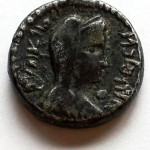Nabataean King Aretas IV
After yet another trip to Israel, my numismatic collection was supplied with several valuable objects. One of such objects is a Nabataean silver drachma minted by King Aretas IV. The weight of the coin is 4,18 grams, its diameter is 18 millimeters. On the coin’s obverse there is a head image of king Aretas facing the right side. There is a crown on the king’s head with an ornament. Around the coin’s perimeter there is a title inscription, “Aretas King of Nabathea, who loved his people.” On the reverse there is an image of Aretas’ first wife – Huldu in a crown and with jewelry, around the perimeter there is a title inscription, “Huldu Queen of Nabathea.” The coins with Huldu’s image were struck between 9 and 16 AD. Later coins that were struck in 18-39 had the image of Areta’s second wife – Shaqilath with the same title inscription.
The years of the reign of Aretas IV (from 9 AD to 40 AD) are considered to be the heyday of Nabataean prosperity. It was at that time, when the most famous architectural monuments of Petra were created. The NabataeanKingdom reached its maximum territory and for a short time stretched as far as Damascus in the north. To the same period belongs the blossoming of Nabataean centers in Negev – Sobata, Elus, Nitzana, Mampsis and Oboda, as well as the foundation of a crucial Nabataean center – Hegra (Madain Salekh) in the north-west of modern Saudi Arabia. Aretas rise to power could radically change the history of the ancient world. When King Aretas IV came to power in 7 BC bypassing August, the latter became angry and even thought of taking the kingdom away from Aretas and of joining Nabathea to Judea. These plans though were never fulfilled.
Aretas is also known because of a marriage between the ruler of Galilee and Perea Herod Antipas, son of the infamous Herod the Great, and his daughter. Little time had passed, when Herod Antipas conceived a wicked passion for his sister in law Herodias, and for her sake he sent his wife away. This fact provoked anger of the Nabataean king.
Later, between the father in law and his son in law there also was an argument because of the borders of Gilead, which resulted in an full-fledged war. In a battle between the two armies Herod Antipas was defeated and would be utterly destroyed by his rival had it not been for the Roman’s intrusion: it was against Roman interests to allow for a great strengthening of Aretas. Emperor Tiberius ordered Syrian governor Vitellius to punish Aretas for his willful actions. The carrying out of this charge was frustrated by the emperor’s death in 37 AD. During emperor Kaligula’s reign, for a short time – between 36 and 40 AD, king Aretas had Damascus under his control.
During a short period of Aretas reign over Damascus, his name is also mentioned in the New Testament. In the Second epistle of Apostle Paul to Corinthians, chapter 11, verses 32-33, there is a record of Paul’s missionary journey to Damascus. The regional ruler of King Aretas was keeping a watch over Damascus to arrest Paul, but Paul was lowered down in a basket from the city wall, thus escaping his hands.
Один комментарий
Leave a Comment
You must be logged in to post a comment.



Уж очень вид и сохран хороший, я сам купил пару такого типа монет Римских и думаю что подделка, но есть как есть